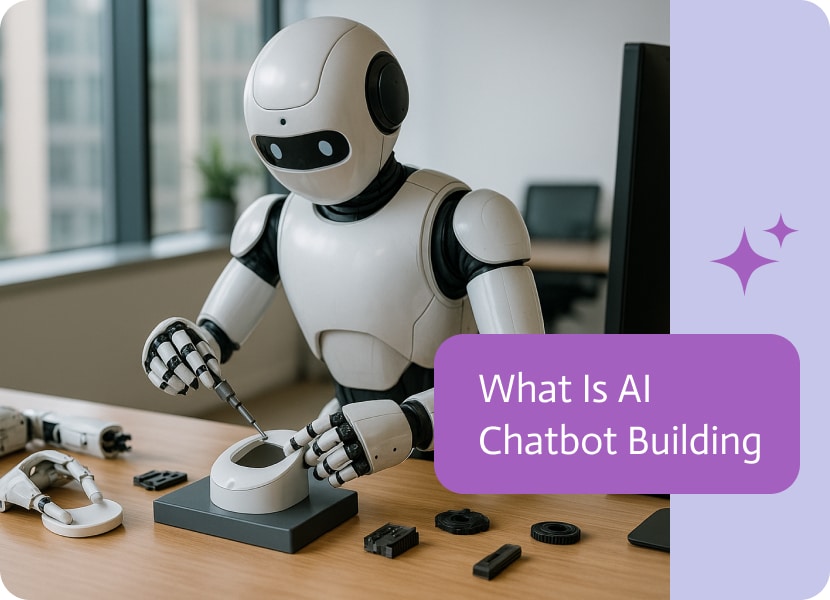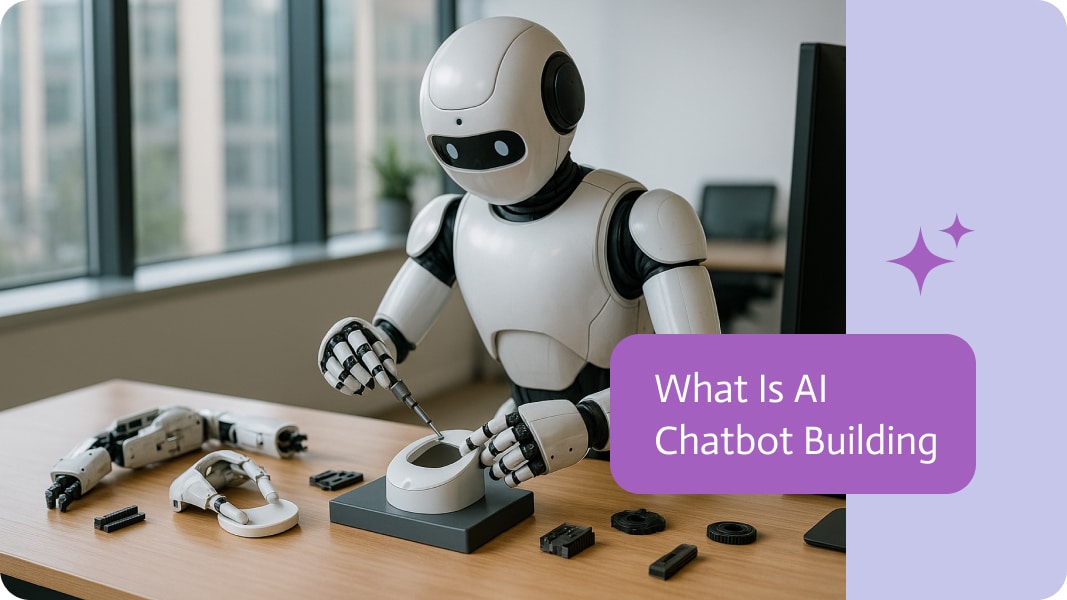

What Is An AI Chatbot And What They Do
They’ve been sneakily popping up everywhere, haven’t they? Now, they’re hard to miss, popping up all over the internet. Seriously, whether you’re buying stuff online, chatting with your bank, getting pizza, or fixing your Wi-Fi, you’ve probably talked to one.
But what are chatbots? Underneath the hype, they’re pretty smart bits of tech. And get this, they’re shaking things up in how we work, chat, and do business.
Breaking An AI Chatbot Down
Essentially, it’s a program built to talk to people the way people talk to each other. Instead of sticking to a set script like older bots, these new assistants lean on machine learning, natural language processing, and large language models. This means they are able to grab the meaning behind a question, reply on-topic, and even get smarter the more they chat.
Another explanation is that chatbots skip the rigid menu and aim to sound natural. They recognize slang, fix the odd typo, and try to answer in plain language. That alone makes them a welcome upgrade from the old press-one-for-billing ancient systems.
APIs use integrations to link a chatbot to databases, CRM tools, calendars, product stocks, and plenty more, so it can do much more than just hold a friendly conversation.
When the parts work in tandem, the bot can suggest shoes, help you book a flight, or even point out errors in your code-like having a pocket assistant 24/7.
Common Use Cases
Customer Support. This remains the biggest arena. Bots tackle FAQs, reset passwords, gather account details, and pass tricky cases to agents.
E-Commerce Assistants. From picking the right size to tracking orders, they serve as ever ready digital sales reps, present day and night.
Healthcare. Appointment booking, mental-health check-ins, and basic triage info are duties a growing number of clinics assign to chatbots.
Education. The AI quizzes students, breaks down difficult topics, and walks them through homework step by step, anytime study hits.
HR and Internal Tools. Companies lean on bots to onboard staff, track PTO requests, and field countless routine questions.
In all these roles, chatbots cut wait times, boost access, and tidy up workflows, making the daily grind that much more palatable
The Evolution of AI Chatbots
Chatbots have been around for a while, but the back-end tech powering them has seen a real makeover. The early programs followed strict scripts and fell silent if you strayed off the menu of set phrases, but this new improved version has changed that rigid world.
With modern versions like OpenAI’s GPT or Google’s Gemini, these virtual helpers can do surprising things in seconds, write an email, summarize a report, swap in another language, or even toss you a fast pun.
Benefits of Chatbots
So why is everyone from tiny side hustles to major banks-racing to add AI bots to their daily lives?
- 24/7 Availability. No coffee breaks, no sleep. Bots are always on.
- Scalability. One bot deals with a plethora of conversations at once.
- Consistency. No bad days or missed message-users get a uniform experience every time.
- Cost-Efficiency. Reduction of large support teams, especially for repeating jobs.
- Data Collection. Conversations all become a source of customer insight.
Limitations and Speedbumps
Even though chatbots still have a long way to go. They sometimes misread what we say, spit out wrong facts, or lock up when a question isn’t clear. LLM’s can catch some subtlety, and yet they still require clearly laid out rules to keep wild guesses or useless replies at bay.
The ethics piece adds extra weight to the whole mix. How honest should you be when a user starts chatting? What bits of personal info get pulled, and where do they end up? As these bots level up, answers to those questions will move from nice-to-have to must-have.
Where Do AI Chatbots Go From here
Chatbots are moving beyond just random chit chat, and that really excites people in tech. Imagine a bot that jumps onto your calendar, books a meeting, files the report you just rattled off, and even checks stock so you don’t even need to lift a finger.
Personalization is in the very near future as chatbots will recall your common bagel orders, the way you phrase requests, and even judge your mood based on how you seemed to be yesterday. Mix that with voice commands and slick new APIs, and the line between assistant and advanced FAQ will practically vanish.
If that sounds far away, give it six months. In a few demos, you can already swipe left on one voice, push play on another, and watch the bot switch gears as quickly as you do.
How Noca Uses A Chatbot to Power Seamless Enterprise Integration
Nocas platform nails the hard part of linking AI with enterprise software: it makes the whole thing feel simple instead of terrifying.
Conversational UI Meets Complex Workflows
Nocas AI chatbot doesn’t just trade pleasantries; it serves as a well-trained front desk for the entire company. Instead of hunting through ten tabs for that overdue invoice, users can tell the bot, Can you pull up the March report? and get results in seconds. Behind the curtain, Noca maps everything so the team never has to see the clutter.
Real-Time Help, No Clicks Required.
Say you have to check support tickets. Just say, “Show me all open support tickets from last week.”
The bot grasps the words, taps the CRM, and pulls fresh data with zero menu clicks from you.
Plug and Play with Loads Tools.
Noca ships with ready connectors for the big apps every team uses: CRM, ERP, or HR, Its integration layer plugs straight into:
- Salesforce
- Slack & Teams
- Workspace & Microsoft 365
- Stripe, Xero, QuickBooks
- Airtable, Notion, Trello, Jira
- SAP, Oracle, Workday** (by API or webhook)
Because Noca’s AI manages the logic, you never need an engineer to hard-wire each link. Ask, “Create a new lead in Salesforce” or “Schedule a leave request in Workday,” and the system routes the task to exactly where it needs to go.
Speak it. Done.
All of this hinges on Nocas’ natural language engine plus no-code workflow tool. When you say, “build a report” or “tweak a record,” the AI reads the context and maps your words to a task.
Instantly, the chatbot becomes both interpreter and worker. It hears your intent, translates it, and gets the job done with almost no delay.
Talk to Your Tech, Securely and Seamlessly
Instead of logging into multiple apps, you ask Noca a question, and it figures out which system to poke first. Then it requests the API call behind the scenes and brings back exactly what you need. In other words, Noca turns your whole tech stack into a friendly conversation.
Built for Business, Because Safety First
When it comes to running a large company, even a small outage or a tiny data leak can cause huge headaches. That’s why Noca is built on enterprise-grade tools from day one:
- Role-based access control keeps sensitive commands away from the wrong eyes.
- Full audit logs let you see who talked to what and when.
- All API traffic travels in military-grade encryption.
- Chatbot replies can change depending on the team, the geography, or even the project.
Admins set the rules once, and Noca sticks to them, whether the sales crew in London or the HR specialists in Atlanta are asking for help.
Less Clicking, More Winning
With Noca steering the apps, employees don’t waste time finding out where to click and more time scoring points for the business. It’s become a universal command center that doesn’t just answer questions; it actually gets things done.
Need to update something? Done. Pull a financial report? Easy. Speed up a product launch and cut through approval delays? That’s the secret sauce.
That’s not even the best part though. Yes, you can go through the whole process of designing your very own chatbot, but why? The point of this is to be efficient right, so why waste time? Noca has their very own pre-built ai chat agent ready to go for anyone looking to get a headstart on the competition.
Final Thoughts
Chatbots do much more than just chat. They connect people, take care of common tasks, and simplify being online. Think of them as tools that turn chats into helpful talks. With prompt to chat bot, businesses can turn simple natural-language instructions into actions the bot performs automatically. For businesses, they keep them competitive. For users, they give quick answers without any trouble.
The next time a friendly voice pops up on your favorite site, pause for a beat. You might be having a chat with some brilliant lines of code, not a person.


